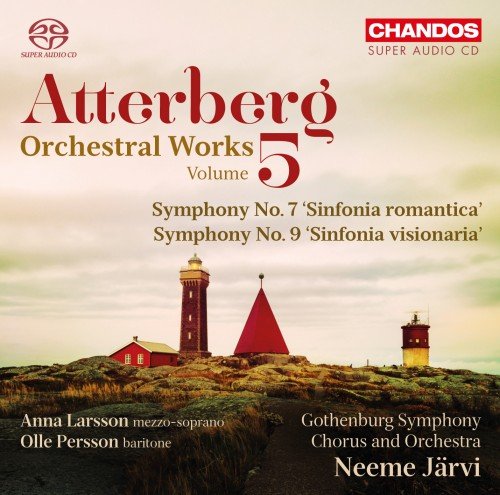
Anna Larsson, Olle Persson, Neeme Järvi - Atterberg: Orchestral Works, Vol. 5 - Symphonies No. 7 & 9 (2016)
BAND/ARTIST: Anna Larsson, Olle Persson, Neeme Järvi
- Title: Atterberg: Orchestral Works, Vol. 5 - Symphonies No. 7 & 9
- Year Of Release: 2016
- Label: Chandos
- Genre: Classical
- Quality: FLAC (tracks)
- Total Time: 01:02:49
- Total Size: 316 mb
- WebSite: Album Preview
Tracklist:
Symphony No. 7, Op. 45 "Sinfonia romantica":
01. I. Drammatico. Lento (12:38)
02. II. Semplice. Andante (8:36)
03. III. Feroce. Allegro (7:22)
Symphony No. 9, Op. 54 "Sinfonia visionaria" *:
04. I. Adagio (2:16)
05. II. Heid hon hette (2:12)
06. III. Jag jättarna minns, i urtid avlade (3:38)
07. IV. Hon sag vida - En ask ser jag stånda (1:28)
08. V. Väl vet hon (2:37)
09. VI. Med spjut sprängde Oden (3:33)
10. VII. Vid heta källors kittel i lunden (3:05)
11. VIII. Jag ser langre fram - Öster i Järnskogen dvaldes den åldriga (Baritone) (1:50)
12. IX. Mycket jag fattat - Bröder varandras bane varda (3:11)
13. X. Hur är det med asar? (1:43)
14. XI. Rym styr ur östern (1:56)
15. XII. Nu stundar Friggas sorg den största (2:11)
16. XIII. Solen svartnar (4:41)
Performers:
Anna Larsson - mezzo-soprano*
Olle Persson - baritone*
Gothenburg Symphony Chorus*
Gothenburg Symphony Orchestra
Neeme Jaarvi, conductor
Symphony No. 7, Op. 45 "Sinfonia romantica":
01. I. Drammatico. Lento (12:38)
02. II. Semplice. Andante (8:36)
03. III. Feroce. Allegro (7:22)
Symphony No. 9, Op. 54 "Sinfonia visionaria" *:
04. I. Adagio (2:16)
05. II. Heid hon hette (2:12)
06. III. Jag jättarna minns, i urtid avlade (3:38)
07. IV. Hon sag vida - En ask ser jag stånda (1:28)
08. V. Väl vet hon (2:37)
09. VI. Med spjut sprängde Oden (3:33)
10. VII. Vid heta källors kittel i lunden (3:05)
11. VIII. Jag ser langre fram - Öster i Järnskogen dvaldes den åldriga (Baritone) (1:50)
12. IX. Mycket jag fattat - Bröder varandras bane varda (3:11)
13. X. Hur är det med asar? (1:43)
14. XI. Rym styr ur östern (1:56)
15. XII. Nu stundar Friggas sorg den största (2:11)
16. XIII. Solen svartnar (4:41)
Performers:
Anna Larsson - mezzo-soprano*
Olle Persson - baritone*
Gothenburg Symphony Chorus*
Gothenburg Symphony Orchestra
Neeme Jaarvi, conductor
The final volume in our Atterberg series with Neeme Järvi and his Gothenburg Symphony Orchestra is finally out. Recorded on SACD like most of the previous ones, it features two late, again rarely performed symphonies.
The seventh, featured here in its final, three-movement form, was written in 1942, fourteen years after its famous predecessor, the Dollar Symphony. Originally in four movements, the work was received dismissively by the critics, and only acquired its final shape in 1969, when Atterberg decided to tear out the last movement from the original score (it became Vittorioso, see Vol. 4). In response to what he regarded as a critical insult, he also decided to baptise the work Sinfonia romantica, just to infuriate the modernistically inclined critics even further.
The composer himself referred to his Ninth and last Symphony as ‘evil’. Setting parts of the Old Icelandic poem Völuspá, it recounts indeed how evil came into the world and how it in the end will lead to total destruction. By this time he had become a very conservative composer, rejecting atonality and dodecaphony. Composed in 1955 and 1956, during a period of much administrative travel in Europe, it is one of his longest works, yet structured as a single movement in large-scale rondo form.
The seventh, featured here in its final, three-movement form, was written in 1942, fourteen years after its famous predecessor, the Dollar Symphony. Originally in four movements, the work was received dismissively by the critics, and only acquired its final shape in 1969, when Atterberg decided to tear out the last movement from the original score (it became Vittorioso, see Vol. 4). In response to what he regarded as a critical insult, he also decided to baptise the work Sinfonia romantica, just to infuriate the modernistically inclined critics even further.
The composer himself referred to his Ninth and last Symphony as ‘evil’. Setting parts of the Old Icelandic poem Völuspá, it recounts indeed how evil came into the world and how it in the end will lead to total destruction. By this time he had become a very conservative composer, rejecting atonality and dodecaphony. Composed in 1955 and 1956, during a period of much administrative travel in Europe, it is one of his longest works, yet structured as a single movement in large-scale rondo form.
Year 2016 | Classical | FLAC / APE
As a ISRA.CLOUD's PREMIUM member you will have the following benefits:
- Unlimited high speed downloads
- Download directly without waiting time
- Unlimited parallel downloads
- Support for download accelerators
- No advertising
- Resume broken downloads


